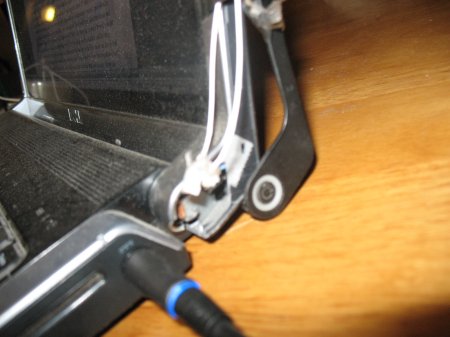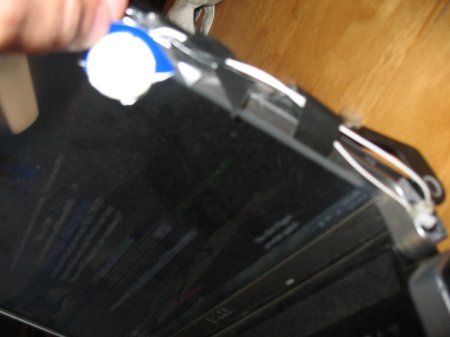
*Hillbilly Computer Fix*
About a year and a half ago a couple of feline vandals knocked the lap top over. This was not the first time they did that, but this time finished off the on/off switch. This is our only computer; no backup and didn't even put any data on a thumb drive or SD card. Dumb I know. My son, a computer systems architect, usually fixes my computer problems but he was living in Alaska at the time. Without the computer being on line there was no way he could help and I did not have a way to go on line and check for wiring diagrams to figure out how to turn the computer on again. There were 3 wires (red, black, and brown) that had originally been attached to the on/ off switch. I knew that the laptop was basically a 12volt system. So, going on the assumption that red was positive and black was negative, all I had to do was figure out what the brown one was for; the screen maybe? I knew that a switch simply opened and closed circuits, kinda of like a water valve in plumbing. A closed circuit lets the power flow; open the circuit and the disconnect stops the flow of electricity. Confused yet? Think of it more like a water hose. If you cut the hose in half the water can't flow to the other end of the hose, right? So, the circuit would be open. Splice the hose back together and the water starts flowing to the far end of the hose again; so the circuit is now closed.

Okay, enough about flows and plumbing analogies. If I needed to close the circuit all I had to do was splice all 3 wires together, right? No, I would soon figure out that was not exactly true on this circuit. I figured I would strip some of the insulation off the wires first, then try simply twisting them together and see what happened. Fortunately for me, as I was trying to use a knife, my wire strippers were too big for the tiny wires and the space was too tight to strip the red wire. I somehow managed to touch the black wire with the tip of the knife, even though I had tried to keep all the wires spread apart until I could prep them for the first experiment. Suddenly the computer jumped to life, startled the mechanic in me, moved my hands back away from the wires, and the sound of the CD drive meant to me “moving parts - get back”. Okay, according to my theory, the wires weren’t touching now so the computer should have turned off. Not so! The computer was still running. Okay, time to think. I knew I had not touched the brown wire, just the red and black and those two were now well apart. Why was this thing still running? The circuit was open! Then it dawned on me, the original switch was a simple push button. Maybe it only temporally closed a circuit to jump start another circuit? I used the start menu to turn the computer off to see if I could duplicate the first results. I used the knife blade to touch the red and black wires again. Computer started up again! Wow, this illiterate hillbilly had just hot-wired a laptop and was going high tech now! The brown wire seems to have been the power to the LED to light the original switch. So, I used the hot wire method for a little while but this was inconvenient and cumbersome to say the least. Holding two very short wires and a knife blade, while trying to make a good connection long enough to start the lap top, was too much of a pain - especially for my wife. Then I remembered that I had saved a “try me” push button switch from a motion activated Halloween decoration. I took the battery out of the laptop. Then I got out my wood burner and put in the soldering tip and the tiny wire silver solder that came with the wood burner (when I bought it new about 5 years ago) and soldered in the “try me” push button switch. This was going to be the first time I had been able to try out the soldering function of the wood burner. The tiny wire solder wouldn't hold, at least not with my soldering technique, and I did not have any flux to try to do it right. So, I pulled out some plumbing solder, with flux core this time, and the connection held. I reinstalled the battery in the lap top, gave the button switch a push, and sure enough the lap top began working.

After thoughts:
I could have gotten injured playing with live wires. I am assuming that the circuit to the start up switch is very low voltage, but I never tested it. Bed Of Nails Alligator Clips would have been a viable option to check the circuit prior to playing with it. My multi-meter has big probes, but the Bed Of Nails will pierce the wire insulation and in so doing will solve that problem. I used to have a set for repairing phone lines when I managed apartments, but loaned them out and never got them back. I do know, however, where the clips are sold in my area.
Trial and error was the option I chose over taking the lap top to a computer tech. I didn't like the price and I find it hard to trust my equipment to a total stranger for a couple of days. I didn't know at the time that there is a shop in my area that will solder boards and switches on the cheap while you wait. I found it a couple of months later.
I now know more than I did about computers.
Feline vandals are banished to the outdoors
I always back up data and work from a thumb drive now
A stand with arms and alligator clips would have made the soldering a lot easier. The stand could have held the wires together while I used my two hands to hold the solder and the iron.
www.alpharubicon.com
All materials at this site not otherwise credited are Copyright © 1996 - 2012 Trip Williams. All rights reserved. May be reproduced for personal use only. Use of any material contained herein is subject to stated terms or written permission.